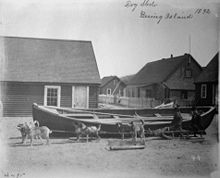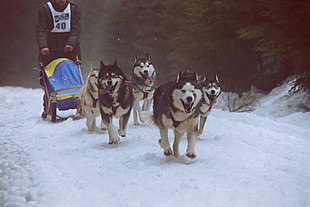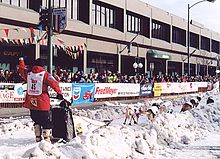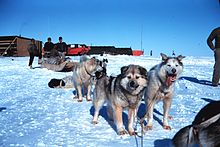Sled dog
A sled dog is any dog that is harnessed to a dog sled in order to pull it with a harness and leash. Sled dogs must be persistent and resistant to the cold.
history

It is not known where and when dogs were first used as draft animals for sleds. It is assumed, however, that this took place in northern Siberia , whose indigenous peoples can look back on a long tradition of winter travel, before any other draft animals were used.
Today there are several breeds of dogs that are specifically used as sled dogs, although any medium-sized breed is suitable for pulling a sled. A few years ago, for example, a team of thoroughbred poodles took part in the Iditarod race. However, the participant took the team out of the race after two days of racing because the poodle skin was not adapted to the weather conditions at the time. Carriage drivers (so-called mushers ) often use other than the typical sled dog breeds or mixed breeds as harnessed animals. During the time of the Klondike gold rush , mixed-breed teams were the norm.
The typical sled dog breeds appeared in the northern regions around 100 BC. BC and developed in the individual tribes to their present day homogeneity. The so-called dog equator in Greenland served to prevent cross-breeding of undesirable characteristics. They were given different names according to the individual tribes; so the dog from Siberia was called " Siberian Husky " and the dog of the Malamutes " Alaskan Malamute ". In 1926 the American Kennel Club established the standard for the Malamute. In its original homeland, the Malamute is very popular for sled races. The typical breeds have coarse, straight and tightly fitting outer hair with a thick, soft undercoat ; they grow up to 70 cm and weigh up to 45 kg.
During the First World War, sled dogs were used by different nations. In the middle of the 20th century, when sled dog races lost public interest, the breeding of sled dogs pursued a division into different breeding goals: On the one hand, breeding lines for so-called showdogs were created, which were optimized in breeding to meet the breed standards as optimally as possible at shows and to meet the breed standards to be presented accordingly, on the other hand the very old, original, purely performance-oriented work-breeding lines were continued to a lesser extent (e.g. Seppala Siberian Sleddogs). In the 1970s, the dog sled races experienced a renaissance and were also held for the first time in Central Europe. Now the advantages of the animals bred in the working lines became apparent.
Even today there are both orientations in the breeding of Nordic dogs, without the buyers of these dogs always being aware of the differences. Therefore, one often finds extremely large differences in the physical performance of Nordic dogs, even in dogs that are very similar in their outward appearance.
Required properties
Sled dogs are required to have high physical and mental abilities. The physical abilities allow good sled dogs with optimal disposition and optimal training to pull a sled over 200 km in 24 hours. Mental abilities consist of the proverbial “desire to go”, the unconditional will to run, which is responsible for ensuring that the willingness to perform is maintained even under prolonged physical strain and under the toughest climatic conditions. Despite the stress , the sled dogs have to understand and implement the commands and be able to find the "right" trail on their own . In short races, sled dogs reach an average speed of 20 to 25 miles per hour (32 to 40 km / h), in long distance races the average cruising speed is still 10 to 14 miles per hour (16 to 23 km / h). Sled dogs can cover a total of up to 10,000 km in one winter. At the same time, the sled dog is characterized by pronounced social behavior , low sensitivity to pain and a strong cardiovascular system , which allows the working dog to develop a metabolism that is sufficient even with scarce food despite all efforts.
Composition of a team
- for driving technique see also: Dog sled

A sled dog team , the so-called team , can consist of two to over 12 dogs. Nowadays, the teams are usually clamped as a double, each attached to a central pull line. The Eskimos of the Arctic also harness their animals as “fans”, with each animal being connected to the sled with its own pulling line. Furthermore, there is the rarely seen tandem restraint, in which the dogs run individually and one behind the other between two parallel pulling lines (one on each side of the animals); this restraint is advantageous in very densely wooded areas and on narrow, winding trails.
In a team under double or tandem tension there are the following positions: Leader - the lead dog (s) and first dog (s) in the team; Wheeler - the dog (s) directly in front of the sledge and Swinger - all other dogs in the team.
The highest demands are made on the leaders , because they set the pace and have to communicate with the musher and implement his commands. The motivation of the whole team is based on them , especially under high physical stress. In addition, they have to find the right path, the trail, largely independently, so that the musher only has to intervene with commands in situations that are dubious for the leaders. Physically, they do the hardest work, especially in deep snow. The orientation and local memory ability of good lead dogs is amazing . Not infrequently, even after years, they recognize a path that was previously taken.
As Wheeler the physically strongest dogs are often used so that their tension is not transmitted via the at large trailer combinations to m to 20 long pulling line has what tight especially in, could lead twisty passages to the fact that the dogs in the central area of the vehicle combination to curve obstacles to be pulled. Wheeler must, apart from the run will not provide special mental performance. Dogs are often used as wheelers in training or those who like to go their own way. They are prevented from doing this by the pulling power of the team members who are running ahead.
The dogs in a team generally know their position in the team and are, in this regard, as in many other areas, very creatures of habit. If the dogs are used very intensively, it can make sense to occasionally swap the two dogs running next to each other in their position, although this is not appreciated by the dogs. The exchange leads to a more even physical load, because the dogs in the described tandem formation always have to pull at an angle to the running direction. Externally, this can manifest itself in the uneven wear of the fur up to the sore skin under the harness.
Sled dog racing as a sport
- Main article: Sled dog racing
In 1925, Balto , the best-known sled dog to this day, achieved worldwide fame. He was the dog who led the sled dog team through ice, snow and blizzards on the last relay race between Anchorage and Nome in western Alaska , with essential medicines in their luggage that were supposed to save the city from a diphtheria epidemic . Inspired by this, the first " Iditarod " race was held in 1973 , which leads over 1,161 miles through frozen land, wilderness and mountain ranges, arctic seas and hard winds. Since then, such races have become a popular winter sport in both North America and Europe .
In Europe, sled dog athletes have now organized themselves into several sports associations, with different goals and structures. The largest association for sled dog sports in Germany is the Association of German Sled Dog Sports Clubs ; Dogs can take part in his events regardless of race. It was created through the merger of the purebred working group of German sled dog sports clubs and the race-independent German sled dog sports association . There are also sports clubs and associations, for example the German umbrella organization for pure-bred sled dog sports , which only practice sled dog sports with the Nordic sled dog breeds, mainly Siberian Husky, Samoyed, Greenland Dog and Alaskan Malamutes.
A large number of sled dog races are held in Europe each year. Once a year the Sled Dog World Championship, the largest sled dog event in Central Europe, takes place. In 2019 it was held in Haidmühle , Lower Bavaria. The race comprises four racing days. Only typical Nordic dog breeds are allowed at the World Cup.
A general distinction is made in dog sled races between chariot races and sled or snow races.
The chariot races have more of a training character. With them, the sled dog teams mainly pull training vehicles. These are three-wheeled, but mostly four-wheeled, vehicles of very different construction, on which the musher stands in a very similar way to a sledge, behind which he can also participate in the movement while walking or pushing. The majority of Central European mushers are forced, due to the lack of snow, to train their dogs predominantly with the training cart instead of the sled.
The real and more important domain of the sled dog sport is the sled race on snow. Comparable to the division of running sports in athletics according to distance, a distinction is made between sled dog races over very different distances. They are called sprint, middle distance and long distance races. The allocation of individual events to one of these categories is made differently from region to region. In Northern Europe and the USA, races that are classified as middle distance in Central Europe may still be referred to as sprints.
In Germany, the division is roughly as follows: sprint races up to (depending on team size) 10–20 km, middle distance 20–50 km, long distance a few 100 km.
From the point of view of the organizers, the effort involved in organizing the event increases according to the length of a race. Therefore, numerous sprint races are offered as chariot races in autumn and as sledge races in the winter season, significantly fewer middle distance races and only a few long distance races in all of Central Europe.
The famous long-distance races that made the dog sled sport popular include the Iditarod in Alaska mentioned above , but also the Yukon Quest (current names are also dependent on sponsors) in Alaska and Canada. Both races take place under the very harsh climatic conditions of the far north and, from a sporting point of view, are extreme in their area, comparable to extreme mountaineering in terms of the demands on the participants.
Less well-known, but no less demanding than the two races mentioned in North America, is an event with a long tradition in Europe, Finnmarksløpet in Northern Norway. This long-distance race, the northernmost long-distance race in the world, is held in two categories every year at the beginning of March, starting from Alta . In the 8-dog team class, a distance of 500 km must be covered, in the 14-dog team class it is 1000 km. The race takes place under almost arctic climatic conditions and places the highest demands on the participants, the dogs, the preparation and the material. Accordingly, the race is placed on a par with the aforementioned North American events.
Sled Dogs and the Conquest of the Poles
Sled dogs played a major role in conquering the North and South Poles . Roald Amundsen used them successfully in the conquest of the South Pole, while Robert Falcon Scott had only inadequate experience in dealing with these animals and, due to this fact, was defeated by Amundsen in the race to conquer the South Pole.
One of the benefits of using it in the polar regions is their easy diet. Sled dogs can be fed with seal meat ; it is not necessary to bring them in expensive feed. Amundsen went even further during his expedition to the South Pole. He shot the dogs he no longer needed and fed their carcasses to the remaining team dogs.
While sled dogs are still used in the Arctic today, they have now disappeared from Antarctica . As a non-endemic species there, for whose maintenance countless seals had to be slaughtered, the provisions of the Antarctic Treaty provided that the animals had to be removed by April 1, 1994. The animals no longer had a real function since snowmobiles functioned reliably. The last 22 sled dogs of the Australian Antarctic Division boarded the Aurora Australis on November 4, 1992 , three of them were born only three months earlier at Mawson Station . They were taken to the northern United States at two facilities in Ely , Minnesota , a few kilometers from the Canadian border, where they were used for tourist sleigh rides: 17 dogs, including the three pups, were sent to the Voyageur Outward Bound School , the remaining five to Paul Schurke's Wintergreen Lodge . The last living Mawson dog, Misty , one of the three pups, died in December 2007 and was cremated. Some of the ashes were brought back to Mawson Station from the USA in 2011 and hung on the wall along with other souvenirs in the former dog room.
The British Antarctic Survey's Antarctic stations were the last to have two dog teams in Antarctica. Because they had a valuable genetic heritage, it was decided to bring them to the Inuit in their ancestral home in Labrador . Before that, in memory of the fifty-year sled dog tradition of the BAS , they should be used again as before for the transport purposes of a last memorial expedition. For this purpose, both dog teams ( Admirals , eight-team and Huns , six-team) were flown to the Alexander-I-Insel on December 14, 1993 , the project carried out there got the code name Lost Heritage (lost heritage). It served cartography work on the Milky Way and Uranus Glacier , as well as ice core drilling work in the center of the island. Accompanied by a camera team (who, however, traveled with them by snowmobile), this project was successfully completed and covered a distance of 250 miles. The report of this trip ended with a quote from Helmer Hanssen , who was responsible for the welfare of the animals in Amundsen's South Pole team:
“Dogs like that, which share man's hard times and strict work, cannot be looked upon merely as animals. They are supporters and friends. There is no such thing as making a pet out of a sledge dog; these animals are worth much more than that. "
“Such dogs, sharing hard times and arduous human labor, cannot simply be viewed as animals. They are helpers and friends. You can't make a pet out of a sled dog; these animals are worth much more. "
On February 8, 1994, the dogs were flown back to the Rothera station and the majority of the staff there then used this very last opportunity to go dog sledding in the Antarctic. When they were flown out for their first stopover in the Falkland Islands , they were the last dogs to enter the Antarctic Protection Zone. After a last stop with great media interest at London Heathrow Airport , they were flown on to Boston and then taken by road to James Bay in Chisasibi , a Cree settlement on the banks of La Grande Rivière , some 20 kilometers downstream from the La Grande hydroelectric power station. 1 . From there they covered the last several hundred kilometers in a sleigh team to their new home Inukjuaq on Hudson Bay .
The project to bring the last sled dogs from Antarctica to Inukjuaq was called Operation Tabarin in reference to the operation of the same name , during which sled dogs were brought from Greenland to Antarctica in order to establish the first British, permanently manned Antarctic stations .
Races
The classic sled dog breeds include:
- Greenland Dog : strong and persistent
- Alaskan Malamute : largest and heaviest sled dog
- Siberian Husky : the smallest and fastest of the classic sled dog breeds
- Canadian Eskimo Dog : wolf-like expression
- Samoyed : mostly pure white fur
Other internationally recognized breeds:
Sled dog types that are not, not yet, or only recognized as a breed by individual breed associations :
Nowadays, the overwhelming majority of dogs participating in sled dog races are not purebred and therefore cannot be clearly assigned to the aforementioned sled dog breeds or are of completely different origin. In the sprint and middle distance range, dogs with a hunting dog-like physique dominate, in whose breeding lines suitable dogs have been and are crossed without observing breed standards from a purely performance-oriented point of view . Dogs of this type are characterized by high power development, especially over shorter distances, and tend to go to their performance limit, possibly even beyond. But in the long run and under harsh climatic conditions, they do not have the resilience of Nordic dogs. Mentally, these dogs are more like domestic dogs and can be trained to be very personal and obedient.
The longer the racing distances, the more the breed characteristics of the original Nordic sled dog breeds emerge in the dogs that have been optimized for this purpose; they are optimally adapted to arctic climatic conditions and continuous performance . Compared to the aforementioned hunting dog-like dogs, dogs of the Nordic type use their productivity more economically, get by with comparatively very little food and, in general, can hardly be overburdened in a harmful way at sufficiently low temperatures. In terms of character, these dogs are still very close to the wolves, have a pronounced social structure in the pack , also often try to clarify the order of precedence with one another with their teeth, are less personal and often have a pronounced will of their own.
literature
- Janna Graham: Sled Runners: About sled dogs , radio feature, 47:34 minutes, direction and realization: the author, production Südwestrundfunk / Deutschlandfunk Kultur 2019, first broadcast on February 15, 2019.
See also
Web links
- Swiss dog sled sport association
- German umbrella organization for sled dog sports with pure-bred animals
- Lower Austrian sled dog sports club
- German-speaking professional association , VDSV
Individual evidence
- ↑ Andreas Reichelt: World Cup of nimble paws. In: Tele Regional Passau 1 (TRP1). Accessed February 27, 2019 (German).
- ↑ The huskies are leaving Antarctica . antarctic. January 1, 2000. Retrieved January 9, 2018.
- ↑ Husky's tale comes full circle - Australian Antarctic Division ( English ) antarctica.gov.au. 2011. Retrieved January 9, 2018.
- ↑ British Antarctic Monument Trust - Ambassadors ( English ) antarctic-monument.org. Retrieved January 9, 2018.
- ↑ Antarctic Bulletin Vol. 13 No. 6 June 1994 ( English , PDF) New Zealand Antarctic Society. P. 249. June 6, 1994. Retrieved January 9, 2018.
- ^ Sara Wheeler: Terra Incognita: Travels in Antarctica . Random House Publishing Group, 2014, ISBN 978-0-8041-5242-6 , pp. 384 ( limited preview in Google Book Search).
- ↑ A Canadian tradition is revived: Sled Runners , Deutschlandfunk Kultur, published and accessed February 16, 2019




